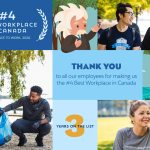What Different Generations Can Teach Each Other About Customer Service



Of all the memes that captured the public’s attention in 2019, ‘OK Boomer” is probably the one companies should keep in mind as they develop their customer service teams. The meme started as a series of dismissive replies to a video on the social media platform TikTok, where an unidentified older
Of all the memes that captured the public’s attention in 2019, ‘OK Boomer” is probably the one companies should keep in mind as they develop their customer service teams.
The meme started as a series of dismissive replies to a video on the social media platform TikTok, where an unidentified older man was criticizing Millennial and Gen Z people for having utopian ideals and not wanting to grow up.
In both the video and the replies, different generations acted as though they were at war with each other. Running a successful business, however, requires bringing them together for the common cause of improving customer experiences.
Some companies may have a service team largely comprised of older generations, and are nervous about hiring younger workers who might not stay for very long, or who are difficult to train.
Other firms may have a workforce that skews younger, and avoid hiring older candidates because they’re not sure if they’ll adapt to new technologies or more sophisticated business processes.
Ageism, obviously, is not the answer in either scenario. It’s also not what employees say they want.
According to a survey of 1,000 adults by recruiting firm Addison Group called Age Is Just A Number: The Truth About Generational Stereotypes At Work, 79% of respondents said they would take a job at a company where the makeup skewed older than them, and 75% would take a job at a company with a younger makeup.
These majorities should inform the way Canadian companies think about the makeup of their own teams, particularly in the customer service area. A generationally diverse customer service team will give you:
1. A richer understanding of customer expectations
Younger service agents might never have gone through the same kinds of experiences as the customers they’re helping, or at least not yet. This can make it difficult to appreciate why certain questions or complaints are considered so urgent by customers, or what the consequences are if they’re not addressed properly.
Older workers can provide the context and background to help their younger peers see the daily lives, interests, aspirations and needs of customers based on all the time they’ve spent helping them. It’s one of the best kinds of “soft training” a younger service agent can get.
That said, this can also work the other way around if the company’s customers are targeted at a younger demographic.
2. An understanding of the etiquette during digital conversations
Older customer service agents may have come up through the ranks primarily dealing with a limited number of communications channels. They might have spent most of their time at a call centre, for example, perhaps adding email to their repertoire as time went along.
Things can look a lot different when you’re fielding issues via public social media posts, or short and possibly cryptic text messages. For Millennials and Gen Z, however, these channels are the lingua franca they use to talk to each other already, so they may be able to decipher certain terms or phrases, or suggest the best ways to respond.
3. Coaching on the norms and nuances of corporate culture
We should never assume older workers are inevitably jaded, just as we shouldn’t assume younger ones are entitled or naive.
In fact, older workers can often provide insight into how a particular firm likes to approach problems, communicate its values to customers and when to escalate certain kinds of decisions.
Even with the best employee onboarding programs, there will always be situations where younger workers ask themselves, ‘Why do we do it this way?” This is where older workers can provide invaluable answers.
4. A fresh pair of eyes, ears and other tools to generate new ideas
Younger workers may not have the same level of work experience as their older peers, but they can still come to work with a wealth of life experience.
Customer service teams have had certain processes in place for years, for instance, but sometimes new approaches need to be taken. That takes brainstorming. A generationally diverse workforce helps with that, where perspectives from younger workers unlock innovative solutions.
5. A representative sample of humanity to complement the technology
Whether a company uses chatbots or is merely following the most successful firms in embracing data-driven automation, technology is completely transforming areas like customer service.
Remember, though, that all those technologies are ultimately in the service of people — people who want to be recognized and treated as individuals, rather than a number.
Even as technologies like artificial intelligence bring value to companies, there will be a need to ensure customer service retains a strong “human element.” A generationally diverse workforce means you’ll be more likely to have a team of agents that looks more like your entire range of customers.
6. A smoother succession plan
Older workers can not only have a high degree of technical proficiency they bring to their jobs, but a lot of institutional knowledge. This could all go out the door when they quit or retire.
Employing younger as well as older customer service team members ensures you are developing a steady stream of potential future leaders. In some cases, this can become a more intentional succession plan, which can help retain younger employees while offering older ones a great opportunity to train, coach and mentor.
Conclusion
Generational diversity in the workplace doesn’t happen by accident. It’s a deliberate choice employers can make, either at the outset if you’re a new company or even if you’ve been in business a long time.
The first step may involve having open discussions with your current team about its existing makeup and why you want to make the change. This may be an opportunity to introduce diversity training that explains the benefits we’ve mentioned in greater detail.
Next will come proactive changes in recruiting, hiring and onboarding, followed by ongoing efforts to support your entire team as it evolves.
No one should be dismissed simply because of their age. Instead, companies should listen to them, look for them, and let them learn from peers of every age.


















